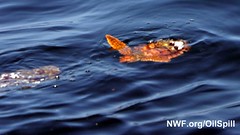We have much more to do and your continued support is needed now more than ever.
Turtle Toll Tops a Thousand as Oil Disaster Impacts Multiply
Since the Gulf oil gusher was capped, wildlife impacts have actually gotten significantly worse.
That seems counter-intuitive. But it’s exactly what wildlife officials are finding along the Gulf Coast:
[W]ildlife officials are rounding up more oiled birds than ever as fledgling birds get stuck in the residual goo and rescuers make initial visits to rookeries they had avoided disturbing during nesting season.
Before BP plugged the well with a temporary cap on July 15, an average of 37 oiled birds were being collected dead or alive each day. Since then, the figure has nearly doubled to 71 per day, according to a Times-Picayune review of daily wildlife rescue reports.
The figures for sea turtles have climbed even higher, with more oiled turtles recovered in the past 10 days than during the spill’s first three months.
Over the weekend, the number of endangered sea turtles collected topped 1,000 (PDF) according to the Deepwater Horizon Response Consolidated Fish & Wildlife Collection Report (includes both live & dead, visibly oiled & not visibly oiled turtles).
Today, the National Wildlife Federation will be following up on yesterday’s sightings of unusual discolorations in Louisiana’s Chandeleur Sound. Our staffers will be heading back out on Chandeleur Sound to take water samples. Keep checking back to Wildlife Promise for updates on what we find.
 Help ensure NWF has the funding needed to be on the front lines helping wildlife >>
Help ensure NWF has the funding needed to be on the front lines helping wildlife >>
For all the latest news on how the oil spill is impacting the Gulf Coast’s wildlife & to learn how you can help, visit NWF.org/OilSpill.























